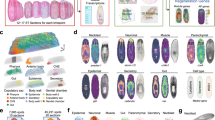Abstract
The earthworm Perionyx excavatus is a species highly capable of bidirectional regeneration. Pair-rule genes are thought to have an ancestral function in arthropod segmentation. However, orthologs in annelids (i.e. Capitella teleta) do not exhibit segmental expression in the ectoderm or mesoderm. Their role in regeneration is currently unclear. Here, we report the expression profile of primary pair-rule genes (Pex-EvxA, Pex-EvxB, Pex-RuntA, Pex-RuntB, Pex-Hes1A, Pex-Hes1B, Pex-Hes4A, and Pex-Hey) found in P. excavatus using semi-quantitative reverse transcription-polymerase chain reaction. Our results indicated these genes showed variable expression during bidirectional regeneration. Six of these genes might play diverse and potentially critical roles in head and/or tail regeneration.




Similar content being viewed by others
References
Bastian H, Gruss P (1990) A murine even-skipped homologue, Evx 1, is expressed during early embryogenesis and neurogenesis in a biphasic manner. EMBO J 9:1839–1852
Brown NL, Sattler CA, Markey DR, Carroll SB (1991) hairy gene function in the Drosophila eye: normal expression is dispensable but ectopic expression alters cell fates. Development 113:1245–1256
Brusca RC, Brusca GJ (1990) Invertebrates. Sinauer Associates, Sunderland
Cho SJ, Koh KS, Lee E, Park SC (2009) Differential expression of three labial genes during earthworm head regeneration. Biosci Biotechnol Biochem 73:2609–2614
Davis RJ, Tavsanli BC, Dittrich C, Walldorf U, Mardon G (2003) Drosophila retinal homeobox (drx) is not required for establishment of the visual system, but is required for brain and clypeus development. Dev Biol 259:272–287
Erséus C, Källersjö M (2004) 18S rDNA phylogeny of Clitellata (Annelida). Zool Scr 33:187–196
Fisher A, Caudy M (1998) The function of hairy-related bHLH repressor proteins in cell fate decisions. Bioessays 20:298–306
Frasch M, Hoey T, Rushlow C, Doyle H, Levine M (1987) Characterization and localization of the even-skipped protein of Drosophila. EMBO J 6:749–759
Fujioka M, Miskiewicz P, Raj L, Gulledge AA, Weir M, Goto T (1996) Drosophila paired regulates late even-skipped expression through a composite binding site for the paired domain and the homeodomain. Development 122:2697–2707
Gates GE (1941) Further notes on regeneration in a tropical earthworm, Perionyx excavatus E. Perrier 1872. J Exp Zool Part A 88:161–185
Glusman G, Kaur A, Hood L, Rowen L (2004) An enigmatic fourth runt domain gene in the fugu genome: ancestral gene loss versus accelerated evolution. BMC Evol Biol. https://doi.org/10.1186/1471-2148-4-43
Gutjahr T, Patel NH, Li X, Goodman CS, Noll M (1993) Analysis of the gooseberry locus in Drosophila embryos: gooseberry determines the cuticular pattern and activates gooseberry neuro. Development 118:21–31
Ingham PW (1988) The molecular genetics of embryonic pattern formation in Drosophila. Nature 335:25–34
Jäckle H, Gaul U, Redemann N (1988) Regulation and putative function of the Drosophila gap gene Kruppel. Development 104:29–34
Kato K, Orii H, Watanabe K, Agata K (2001) Dorsal and ventral positional cues required for the onset of planarian regeneration may reside in differentiated cells. Dev Biol 233:109–121
Klinger M, Gergen JP (1993) Regulation of runt transcription by Drosophila segmentation genes. Mech Dev 43:3–19
MacDonald PM, Ingham P, Struhl G (1986) Isolation, structure, and expression of even-skipped: a second pair-rule gene of Drosophila containing a homeobox. Cell 5:721–734
McHugh D (1997) Molecular evidence that echiurans and pogonophorans are derived annelids. Proc Natl Acad Sci USA 94:8006–8009
Nüsslein-Volhard C, Wieschaus E (1980) Mutations affecting segment number and polarity in Drosophila. Nature 287:795–801
Nüsslein-Volhard C, Kluding H, Jürgens G (1985) Genes affecting the segmental subdivision of the Drosophila embryo. Cold Spring Harb Symp Quant Biol 50:145–154
Rushlow CA, Hogan A, Pinchin SM, Howe KM, Lardelli M, Ish-Horowicz D (1989) The Drosophila hairy protein acts in both segmentation and bristle patterning and shows homology to N-myc. EMBO J 8:3095–3103
Seaver EC, Yamaguchi E, Richards GS, Meyer NP (2012) Expression of the pair-rule gene homologs runt, Pax3/7, even-skipped-1 and even-skipped-2 during larval and juvenile development of the polychaete annelid Capitella teleta does not support a role in segmentation. Evodevo. https://doi.org/10.1186/2041-9139-3-8
Walrad PB, Hang S, Joseph GS, Salas J, Gergen JP (2010) Distinct contributions of conserved modules to Runt transcription factor activity. Mol Biol Cell 21:2315–2326
Acknowledgements
This work was supported by a Grant (CABX, No. PJ010001) from the Next-Generation BioGreen 21 Program funded by Rural Development Administration, Republic of Korea. This work was also supported by the research fund of Hanyang University (HY-2011-N to T.W.K), Republic of Korea.
Author information
Authors and Affiliations
Corresponding authors
Ethics declarations
Conflict of interest
All authors, Yun-Sang Yu, Jin-Se Kim, Brenda Irene Medina Jiménez, Tae-Wuk Kim, and Sung-Jin Cho, declare that they have no conflict of interest.
Ethical approval
This article does not contain any studies with human subjects or animals performed by any of the authors.
Electronic supplementary material
Below is the link to the electronic supplementary material.
13258_2018_683_MOESM1_ESM.pptx
Supplementary material 1: Fig. 1. Phylogenetic analysis of Perionyx excavatus pair-rule genes. Phylogenetic tree of pair-rule genes and related transcription factors reconstructed with Neighbor-joining method and Jones–Taylor–Thornton (JTT) model. Sequences were taken from UniProt database. Bootstrap values are results from 1000 replicates. All branches with a bootstrap value < 50 % are collapsed. a Analysis of Even-skipped homeodomain of Pex-Evx and of other Even-skipped family members with Engrailed genes as outgroup. b Analysis of Runt domain of Pex-Runt and other Runt family members with Id1 genes as outgroup. c Analysis of both bHLH and Orange domains of Pex-Hes and other Hes family members with Twist genes as outgroup. d Analysis of both bHLH and Orange domains of Pex-Hey and other Hey family members with Twist genes as outgroup. Abbreviations: Pex Perionyx excavatus, Hro Helobdella robusta, Cte Capitella telata, Lgi Lottia gigantea, Pdu Platynereis dumerilii, Iob Ilynassa obsoleta, Ttr Theromyzon trizonare, Dme Drosophila melanogaster, Tca Tribolium castaneum, Nve Nematostella vectensis, Afo Acropora formosa, Hsa Homo sapiens, Mmu Mus musculus. (PPTX 192 KB)
Rights and permissions
About this article
Cite this article
Yu, YS., Kim, JS., Jiménez, B.I.M. et al. Differential expression of primary pair-rule genes during bidirectional regeneration in Perionyx excavatus. Genes Genom 40, 747–753 (2018). https://doi.org/10.1007/s13258-018-0683-3
Received:
Accepted:
Published:
Issue Date:
DOI: https://doi.org/10.1007/s13258-018-0683-3




